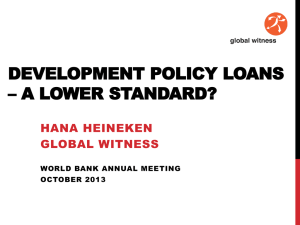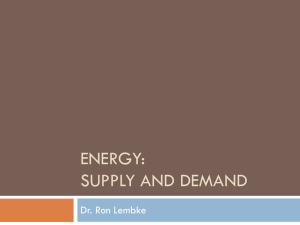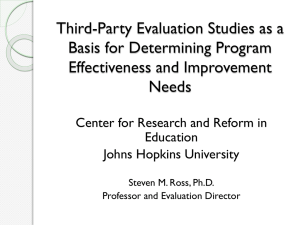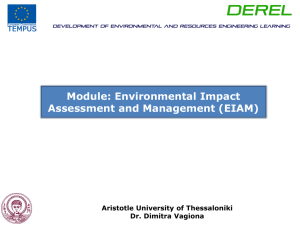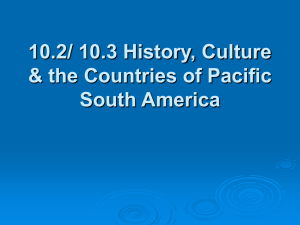ENVIRONMENTAL DPL IN PERU
advertisement
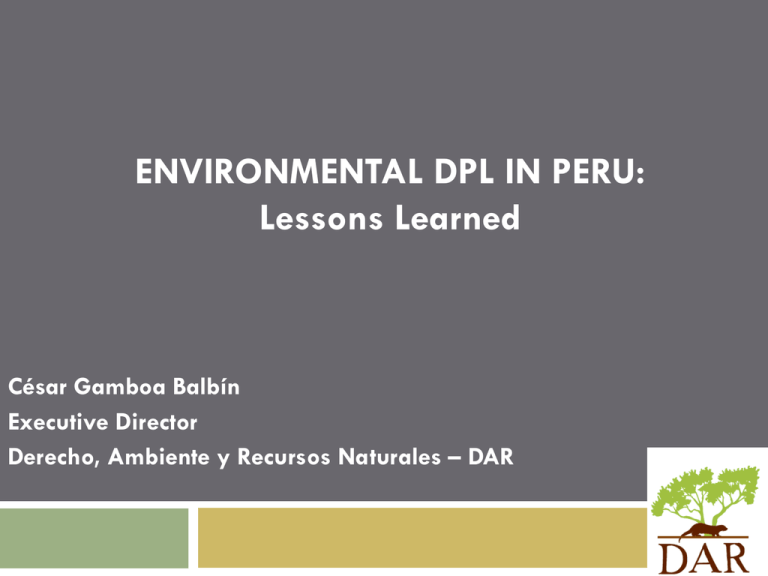
ENVIRONMENTAL DPL IN PERU: Lessons Learned César Gamboa Balbín Executive Director Derecho, Ambiente y Recursos Naturales – DAR Background DPLs are instruments that can be very useful for highrisk environmental reforms Improvement of the environmental and social management of decisions and projects Three DPLs 2008-2011 (+ $400 million) to improve environmental and social management of EIA, among other things BACKGROUND: IMPROVEMENT IN THE NATIONAL SYSTEM OF ENVIRONMENTAL AND SOCIAL MANAGEMENT OF PROJECTS 1. There was no SEA implementation 2. There was no improvement of intersectoral coordination 3. Criticism of EIAs in the mining, hydrocarbon and electric sectors 4. Prior consultation of indigenous peoples was not respected Therefore, socio-environmental conflicts … DPL RESULT: BETTER ENVIRONMENTAL IMPACT ASSESSMENTS? Environmental Impact Assessments Improvements in Instruments of Environmental Management Indicators for Environmental DPLs in Peru At the National System of Environmental Impact Assessment level Adaptation of the sectoral environmental regulations to the framework of the National System of Environmental Impact Assessment Approval of regulations for the National System of Environmental Impact Assessment (not valid) At the Strategic Environmental Assessment (SEA) level Implementation of SEA, especially in the energy sector, in programs like hydroelectric facilities in the Amazon. Implementation of a SEA in Peru (no compliance) Improve the baseline study (ecosystem analysis, economic consideration of the value of natural resources and At the Environmental environmental services, as well as of Impact Assessment environmental and social impacts). approval level Improve the Environmental Management Strategy, especially social impacts. Approval of a certain number of EIAs between 2008 and 2011 (without taking into account the EIAs of emblematic mining, hydrocarbon, hydroelectric projects) CONGA MINING PROJECT: HALTED 1. An expert report on Conga, complementary to the Conga Mining Project’s EIA (Newmont) questions the quality of the EIA 2. Conga, La Granja, Michiquillay, Galeno, Pucamarca, Tía María, Río Blanco, Toquepala, Cañariaco and the other projects that have been stopped already add up to US$ 22 billion. Camisea Gas Project: Disorganized Investments in the Same Mining Area - - Project to expand the operations of “Block 88”: The EIA has yet to be approved because of its effects on isolated indigenous communities; the opinions of the sectors have been delayed and have been questioned despite the new reduction of the deadline for EIA approval to 6 months CREATION OF INSTITUTIONALISM TO APPROVE CATEGORY A EIAS Loss of confidence in the approval of EIAs A new institution was created that depends on the Ministry of the Environment and that has not yet begun to operate (2012). This has produced tension between sectors. Peru’s National Service of Environmental Certification (SENACE) Law: 1.3 “SENACE is the entity responsible for reviewing and approving the Environmental Impact Assessments listed (…) except for the Environmental Impact Assessments listed that are expressly excluded by the Council of Ministers, which will be evaluated by the sector.” CONCLUSIONS AND RECOMMENDATIONS 1. The experience of environmental DPLs in Peru must be viewed from a critical perspective in order to improve an instrument that can be more effective if it includes environmental and social risk assessment in its design phase, in its monitoring, and in its results. 2. Clearly, we must move beyond quantitative indicators to qualitative ones to measure results, to monitor them, and to ensure that they represent changes to the environmental management of a country that lives through social and environmental conflicts due to the low quality of its environmental management and the distrust of stakeholders. 3. The Bank must begin to broaden the way in which it evaluates the risks of DPLs to include those affected and those involved. Civil society can support this review process by exchanging knowledge if there is greater transparency and participation. 4. The Bank must include DPLs in its safeguards review process, since the current DPL policy does not guarantee a better performance for this type of loan. Thank you! Cesar Gamboa cgamboa@dar.org.pe Derecho Ambiente y Recursos Naturales, DAR www.dar.org.pe
